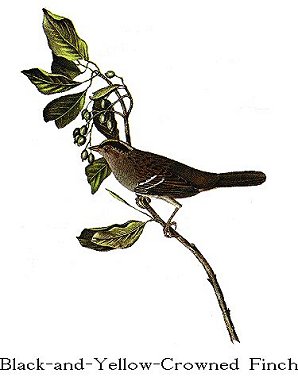
| Family XV. FRINGILLINAE. FINCHES. GENUS IX. FRINGILLA, Linn. FINCH. |
Next >> |

Family |
BLACK-AND-YELLOW-CROWNED FINCH. [Golden-crowned Sparrow.] |
| Genus | FRINGILLA ATRICAPILLA, Gmel. [Zonotrichia atricapilla.] |
The only account which I have received of this handsome Finch, long since
known to the ornithologist, is from Mr. NUTTALL:--"We first observed the young
of this species on the central table-land of the Rocky Mountains, in the
prairies, and mostly running on the ground. We heard no note from them. We
afterwards saw a few stragglers, in the early part of winter, in the thickets of
the forests of the Columbia river, near Fort Vancouver, accompanying the
Fringilla leucophrys. It is probable that they come there to pass the cold
season. They are equally seen at this time, and until late in the spring, in
the woods and thickets of Upper California.
Male, 8, wing 3 5/12.
Rocky Mountains and Columbia river. Rare. Migratory,
EMBERIZA ATRICAPILLA, Gmel. Syst. Nat., vol. i. p. 875.
BLACK-AND-YELLOW-CROWNED FINCH, Emberiza atricapilla, Aud. Orn. Biog.,vol. v. p. 47.
Adult Male.
Bill short, stout, narrower than the head, conical, somewhat compressed
toward the end, acute; upper mandible with its dorsal outline nearly straight,
the ridge convex and obscure, the sides rounded, the edges somewhat inflected,
with a very small notch at the end, the tip a little declinate; lower mandible
with the angle short and rounded, the dorsal line slightly convex, the sides
rounded, the edges involute, the point acute. The gap-line nearly straight, at
the base a little declinate; the palate concave. Nostrils basal, roundish,
open, partially concealed by the feathers.
Head rather large, ovate; neck short; body full. Legs of moderate length,
rather stout; tarsus of moderate length, compressed, covered anteriorly with
seven scutella; toes rather large, scutellate above, the first stronger, the
lateral nearly equal, the third and fourth connected at the base. Claws rather
long, moderately arched, slender, compressed, laterally grooved, acute.
Plumage full, soft, and blended. Wings of ordinary length; the first quill
two and a half twelfths shorter than the second, which is longest, but scarcely
exceeds the third, which in like manner is very slightly longer than the fourth,
the other primaries moderately graduated; the outer secondaries slightly
emarginate, the inner not elongated. Tail long, rounded.
Bill reddish-brown, dusky toward the point; feet flesh-coloured, claws
dusky. The upper part of the head is black, with a longitudinal median band of
yellow, changing behind to grey; upper parts yellowish-brown, tinged with grey,
the feathers of the fore part of the back, scapulars, and wing-coverts with a
central dusky spot; quills and larger coverts dark brown, bordered with
reddish-brown, paler on the primaries; the tips of the first row of small
coverts, and of the secondary coverts, white, forming two bands across the wing.
Tail greyish-brown, the feathers edged with yellowish-grey. The sides of the
head, throat, fore part and sides of the neck, sides of the body, and fore part
of the breast, light grey, the sides tinged with yellow, the rest of the lower
parts brownish-white.
Length to end of tail 8 inches; bill along the ridge (5 3/4)/12; wing from
flexure 3 5/12; tail 3 5/12; tarsus (11 1/2)/12; hind toe (4 1/2)/12, its
claw (4 1/4)/12; middle toe 8/12, its claw (3 1/2)/12.
A young male, shot by Mr. TOWNSEND, on the Rocky Mountains, on the 12th of
July, 1834, has all the upper parts dull yellowish-grey, streaked with dusky;
the wings and tail dusky brown, the quills edged with reddish-brown, the two
bands on the coverts light reddish-brown; the lower parts whitish, streaked with
dusky, the throat white, with a band of dusky spots on each side from the lower
mandible.
| Next >> |